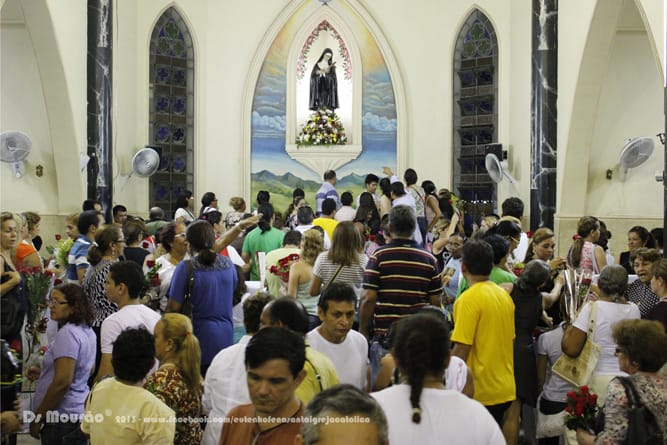The 22nd of May is a marked in red in the calendar of the Augustinian Recollect. It is the feast of St. Rita, and in many places it is a day of multitudes. It doesn’t matter that it be a working day, like this year. The faithful will go either earlier, or in the afternoon, after work, but they will not fail to visit the Saint, participate in the Mass and possibly confess.
The geography is very varied and covers both Europe and the Americas (Venezuela, Brazil, Colombia), and the Philippines. It occurs in big cities, like Manaos, Maracaibo, Manila, Belém do Pará or Madrid, and in small towns like San Millán de la Cogolla, Rioja, Spain or in faraway places like Tapauá. Many times in the shelter of the houses of formation of the Augustinian Recollects (Pozos de Santa Ana, in Costa Rica, Marcilla or Monachil; sometimes in parishes administered by them, like those of St. Rita and St. Florentina in Madrid, or the one dedicated to the Saint of Casia en Manaos, Brazil); or in chapels located in parochial territories, as in the case of Maracay and Maracaibo, in Venezuela. The same happens frequently in the surroundings of the cloistered Augustinian Recollects nuns in the Monastery of San Cristobal (St. Christopher), in Villagarcía de Arosa (Pontevedra, Spain), where the feast is celebrating its 100th year.
Popular and Social
The feast is eminently popular. It is because it has wide acceptance, and also because of the social orientation that characterizes it. A good proof of its acceptance is the novena, that frequently prepares for it (in Belém, Marcilla, Maracay, Manaos or St. Rita of Madrid) and above all of the great affluence of the faithful on the 22nd of May. This massive assistance is counted by thousands of people and demands the multiplication of the number of masses (7 in Santa Rita de Madrid, 8 in Marcilla) as well as the number of confessors, administering for hours the sacrament of forgiveness. Sometimes crowds exceed the capacity of the temples and demand the organization of field celebrations, as has happened this year in Tapauá, Manaus, Monachil and Pozos de Santa Ana.
Social orientation is always present and is very varied, as varied are the circumstances of each place. The case of Tapauá, which gives a fertile mixture of religious spirit and social sensitivity is spectacular. Feasts are opportunities of bringing the communities together, working together, celebrating and strengthening faith. On the one hand, this year they have celebrated the baptism of more than 80 children and some adults. On the other hand, following the custom, they have organized marches of sensibility, this time on the problem of the abuse of minors.
In Honiton, around the National Center of devotion to the Saint, sensitivity manifests itself in the prayer for the sick. In the procession of the Eucharistic offerings the book that contains the names of all those who have asked for prayers is presented. And part of the leftover roses are dried and sent to those who request them. In Maracaibo, the preacher of this year has preferred to insist on the preaching example of St. Rita, inviting everyone to be builders of peace leaving aside the god or idol of politics.
The Celebration
 Tapauá. Celebration of Santa Rita. Demonstration against the sexual abuses Obviously, the core of the feast is always the Eucharist intended to be celebrated with the greatest solemnity possible. In the case of san Millán de la Cogolla, it has consisted in the ringing of the bells. But in Manaus they have had the privilege of being presided over by the Archbishop, Sergio Castriani, and also of counting with the presence of the Bishop of Labrea, the Augustinian Recollect Jesús Moraza. Same is happened in Belém do Pará, where the principal eucharist has been presided by the archbishop Alberto Taveira, and the auxiliary bishop Teodoro Mendes presided another one.
Tapauá. Celebration of Santa Rita. Demonstration against the sexual abuses Obviously, the core of the feast is always the Eucharist intended to be celebrated with the greatest solemnity possible. In the case of san Millán de la Cogolla, it has consisted in the ringing of the bells. But in Manaus they have had the privilege of being presided over by the Archbishop, Sergio Castriani, and also of counting with the presence of the Bishop of Labrea, the Augustinian Recollect Jesús Moraza. Same is happened in Belém do Pará, where the principal eucharist has been presided by the archbishop Alberto Taveira, and the auxiliary bishop Teodoro Mendes presided another one.
Together with the mass there can be a procession. Those in Belém, Manaos and Monachil were crowded but, in general, the route it follows is not through the streets. In Marcilla, it has taken place through the gardens of the convent. And in San Millan de la Cogolla, due to the threat of rain, it has taken place through the magnificent processional cloister of the monastery. Only in places like Tapauá they have been allowed to organize, in connection with the feast, civic manifestations through the streets.
The element that cannot be absent are the roses. Roses by the thousands, that should be taken from wherever: they are cultivated, purchased, received in donations, the faithful themselves carry them… Each attendee to the feast must have his/her rose and takes several to relatives or acquaintances. In places like Tapauá, where it is impossible to find roses, they replace them with candles. And, in the Seminary of de Pozos, the physical presence of the flower is sublimated in artistic representations of St. Rita as a rose; almost a hundred of these frames have been sold.
Wherever it exists, the presence of the Augustinian Recollect Fraternity is prominent. It has special importance in Marcilla, where very early it has taken care of missionary raffle, at the entrance of the convent. Not in vain this Fraternity bears the name of St. Rita of Casia, the same name by which the people call the convent.


